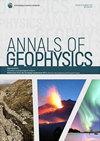Investigating Mt. Etna lava fountains by seismic and infrasonic signals: 14-21 February 2021 case study
IF 1.2
4区 地球科学
Q3 GEOCHEMISTRY & GEOPHYSICS
引用次数: 0
Abstract
Infrasonic and seismic tremor are signals released by active volcanoes. These signals play a crucial role in monitoring volcanic activity and providing insights into volcanic dynamics and hazards. Between December 2020 and February 2022, Mount Etna was characterized by an intense eruptive period, during which monitoring efforts were employed to investigate the characteristics and source signals. Our work focuses on analyzing volcanic tremors in both seismic and infrasound signals to understand their behavior and relationship with the volcano’s dynamics. In particular, the interval 14‐21 February 2021, comprising 4 lava fountain episodes, was taken into account. Concerning the data analysis, amplitude, spectral content, seismic volcanic tremor and infrasonic explosion‐quakes source locations have been computed. The results reveal that the seismic amplitude is closely related to emitted magma volume during the lava fountains. The study finds that most of the energy in volcanic tremors is concentrated below 5.0 Hz. During eruptive episodes, both seismic and infrasound signals exhibit lower frequencies, with variations between different stations due to propagation effects. Finally, two different source mechanisms of the seismic tremor were suggested: i) flow of gasses through a shallower permeable solid layer is likely to be responsible for the generation of volcanic tremor during non‐eruptive periods; ii) magmatic flows along the shallow plumbing system and the consequent impact of particles on the walls of the conduit during eruptive periods.通过地震和次声波信号调查埃特纳火山熔岩喷泉:2021 年 2 月 14-21 日案例研究
次声波和地震震颤是活火山释放的信号。这些信号在监测火山活动以及深入了解火山动态和危害方面发挥着重要作用。2020 年 12 月至 2022 年 2 月期间,埃特纳火山处于强烈喷发期,我们在此期间开展了监测工作,以研究其特征和震源信号。我们的工作重点是分析地震和次声信号中的火山震颤,以了解它们的行为以及与火山动态的关系。我们特别考虑了 2021 年 2 月 14 日至 21 日这段时间,其中包括 4 次熔岩喷泉事件。在数据分析方面,计算了振幅、频谱内容、地震火山震颤和次声爆炸震源位置。结果表明,地震振幅与熔岩喷泉期间喷出的岩浆量密切相关。研究发现,火山震颤的大部分能量集中在 5.0 赫兹以下。在火山喷发期间,地震信号和次声信号的频率都较低,不同台站之间由于传播效应而存在差异。最后,提出了两种不同的震源机制:i) 气体流经较浅的可渗透固体层可能是非喷发期产生火山震颤的原因;ii) 岩浆沿浅层管道系统流动,以及由此产生的喷发期颗粒对导管壁的影响。
本文章由计算机程序翻译,如有差异,请以英文原文为准。
求助全文
约1分钟内获得全文
求助全文
来源期刊

Annals of Geophysics
地学-地球化学与地球物理
CiteScore
2.40
自引率
0.00%
发文量
38
审稿时长
4-8 weeks
期刊介绍:
Annals of Geophysics is an international, peer-reviewed, open-access, online journal. Annals of Geophysics welcomes contributions on primary research on Seismology, Geodesy, Volcanology, Physics and Chemistry of the Earth, Oceanography and Climatology, Geomagnetism and Paleomagnetism, Geodynamics and Tectonophysics, Physics and Chemistry of the Atmosphere.
It provides:
-Open-access, freely accessible online (authors retain copyright)
-Fast publication times
-Peer review by expert, practicing researchers
-Free of charge publication
-Post-publication tools to indicate quality and impact
-Worldwide media coverage.
Annals of Geophysics is published by Istituto Nazionale di Geofisica e Vulcanologia (INGV), nonprofit public research institution.
 求助内容:
求助内容: 应助结果提醒方式:
应助结果提醒方式:


